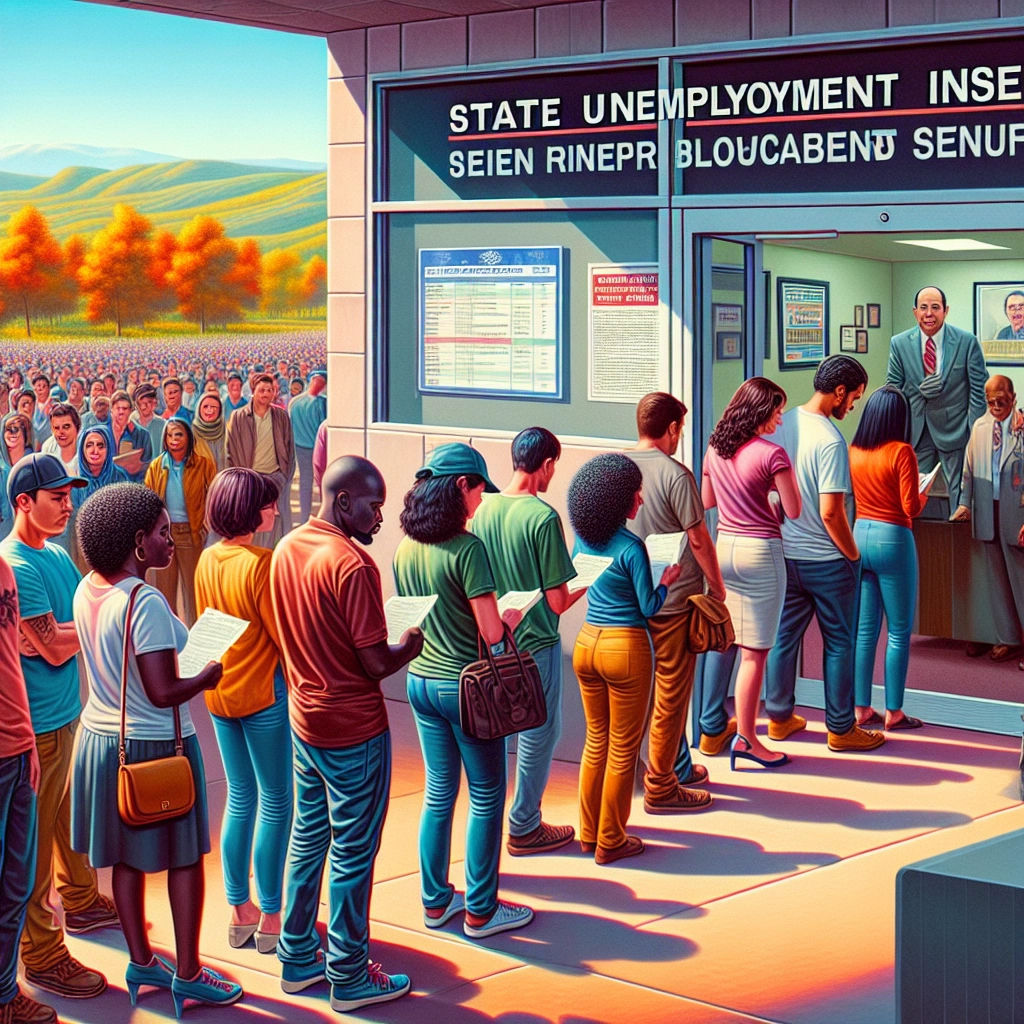Significant Provisions Of State Ui Laws Explained


State UI laws vary from state to state, governing workers’ coverage, benefit eligibility, and financing methods for unemployment insurance. Understanding the significant provisions of these laws is crucial for both employers and employees to navigate the system effectively.
This article aims to provide a comprehensive overview of the significant provisions of state UI laws, offering valuable insights for those seeking information on the topic.
Understanding State UI Laws
Definition of state UI laws
Unemployment Insurance (UI) laws are regulations established at the state level to provide financial assistance to workers who have lost their jobs through no fault of their own. These laws ensure that eligible individuals receive temporary financial support while they actively seek new employment opportunities.
History of state UI laws in the US
State UI laws have a rich history in the United States, with the first program introduced in Wisconsin in 1932. The federal Social Security Act of 1935 then extended this program nationwide, with the administration being decentralized to individual state governments. Over the years, these laws have evolved to adapt to the changing economic landscape and workforce needs, reflecting the commitment to assist individuals during times of unemployment.
Key Provisions of State UI Laws
Eligibility requirements
To qualify for unemployment insurance benefits, individuals must be determined to be unemployed through no fault of their own as per state law. Additionally, they need to meet specific eligibility requirements, including work and wage requirements.
Each state sets its own guidelines, but generally, individuals need to have been separated from their last job due to a lack of available work.
Benefit calculation methods
The benefit amount is typically based on a percentage of an individual’s earnings over a recent 52-week period, up to a state maximum amount. States use various methods for calculating the benefit, with the high-quarter method being the most common, used by 22 states in 2021. This method determines benefit amounts based on the quarter in which the worker earned the most wages during their base period.
Duration of benefits
States typically set the maximum benefit duration as a fixed number, with the extended benefits program potentially providing additional weeks during periods of high unemployment. Some states have also utilized statewide unemployment rates to adjust the maximum duration.
| Maximum Duration | Additional Information |
|---|---|
| Fixed number set in statute | Extended benefits program may provide extra weeks |
Eligibility Requirements
For you to be eligible for unemployment benefits, there are certain work and wage requirements that must be met. The primary condition is that you must have lost your job due to lack of work, including instances such as seasonal employment ending or the elimination of your job position.
If you meet these criteria, you may be eligible to collect benefits.
Work and wage requirements
The reason for job separation plays a crucial role in determining eligibility for unemployment benefits. To qualify for benefits, you must either be unemployed or working reduced hours through no fault of your own.
This could include situations such as a layoff, reduction in hours, a non-conduct related termination, or leaving the job for valid work-related reasons.
Reason for job separation
In addition to meeting work and wage requirements, you are also required to fulfill availability and job search requirements to remain eligible for unemployment benefits. This means actively seeking new employment opportunities and reporting your job search activities regularly to the state’s unemployment insurance agency.
Availability and job search requirements
It is important to understand that unemployment benefits are designed for those who are unemployed through no fault of their own. Voluntarily leaving a job without valid reasons may disqualify you from receiving benefits.
Jobs Service offices and state-specific requirements provide crucial support and guidance to aid individuals in fulfilling the job search requirements to remain eligible for benefits.
Benefit Calculation Methods
| Base Period |
|---|
| The base period is a crucial time frame used to evaluate an individual’s entitlement to benefits based on their earned wages and hours worked. Typically, almost all states consider the first four of the last five completed calendar quarters preceding the filing of the claim as the base period. |
| Weekly Benefit Amount |
|---|
| The determination of the weekly benefit amount relies on the wages earned during the base period. This amount is what an individual receives if eligible for a full week of unemployment insurance benefits. It is calculated based on how much the individual was paid during the base period, typically representing one year of work and wages. |
| Maximum Benefit Amount |
|---|
| The maximum benefit amount generally represents a monetary cap, often calculated by multiplying the weekly benefit by 26. This implies that if an individual qualifies for partial unemployment benefits, there is a limit to the total amount they can receive. |
Duration of Benefits
Long term disability insurance benefits can last for several years or even up to retirement, offering crucial support to individuals who are unable to work due to disability. Short-Term Disability policies typically have a waiting period of 0 to 14 days with a maximum benefit period of up to two years, ensuring immediate assistance to those in need.
Additionally, the basic Extended Benefits program provides up to 13 additional weeks of benefits during periods of high unemployment, with some states offering a voluntary program for up to 7 extra weeks (a maximum of 20 weeks).
| Program | Additional Benefit Weeks |
|---|---|
| Extended Benefits | Up to 13 weeks |
| Voluntary Program | Up to 7 weeks |
The economic conditions greatly impact the state UI laws, as the value of remaining in the labor force may be directly affected by the more generous benefit duration. Such economic conditions are systematically monitored by various stakeholders, including government entities and corporations, through the release of economic data in the form of lagging and leading indicators.
Comparison of State UI Laws
Variations in eligibility criteria
In Alabama, individuals need to have earned minimum wages determined by a specific formula. In contrast, Alaska looks at the base period wages and determines using a two-tier system.
On the other hand, California considers the past 18 months but has minimum earnings requirements and an alternative earnings qualification.
Benefit amounts in different states
In Texas, the weekly benefit amount is about 26% of the claimant’s wages in the highest-paid quarter of the base period. In Ohio, it’s approximately 50% of the average weekly wage during the highest quarter of the base period.
Meanwhile, New York provides a maximum of $504 per week to qualified individuals.
Maximum benefit duration in each state
In Iowa, qualified individuals can receive unemployment benefits for a maximum of 26 weeks. However, in Massachusetts, the maximum duration is 30 weeks, while in Florida, it is limited to 12 weeks.
This substantial variation in benefit duration across states significantly impacts the support available to the unemployed.
Legislative Changes and Updates
Impact of legislative changes
The recent legislative changes have had a significant impact on the state UI laws, especially in the context of unemployment benefits. For instance, the Consolidated Appropriations Act of 2021 extended the authorization of UI programs and created the Mixed Earner Unemployment Compensation (MEUC), which notably impacted the eligibility criteria for unemployment benefits.
Additionally, the implementation of UI program integrity measures sought to address flaws in the current policy, improving the overall efficacy and fairness of the benefits system.
Pending bills and proposals
There are several pending bills and proposals that could bring about further changes to the state UI laws. For example, the upcoming proposed UI reforms aim to correct flaws in the current policy, such as increasing UI benefit levels and addressing low wage-replacement rates.
Additionally, the introduction of comprehensive UI reform legislation in the 117th Congress sought to expand eligibility, raise benefit levels, and establish a guaranteed minimum duration for receiving benefits in all states.
Effects on UI benefits
These legislative changes have directly impacted UI benefits, offering relief to unemployed individuals while introducing critical adjustments to the eligibility criteria. The relief measures, such as excluding a portion of UI benefit income from federal income taxation, have provided tangible financial assistance to those affected by unemployment during the specified period.
Moreover, the Permanent-Law Programs and the COVID-19 Pandemic Response legislation highlighted the significance of ensuring a robust and responsive UI system to address the needs of unemployed workers during economic downturns.
Compliance and Enforcement
Employer responsibilities
Employer responsibilities under the significant provisions of state ui laws include providing a safe workplace environment free from recognized hazards. This involves compliance with standards, rules, and regulations issued under the OSH Act, ensuring that workplace conditions conform to applicable OSHA standards, and maintaining safe tools and equipment for employees’ use.
Employee responsibilities
Employees also have responsibilities under the state ui laws, including the obligation to adhere to workplace safety regulations, use provided tools and equipment in a safe manner, and report any potential hazards or safety concerns to their supervisors promptly.
Penalties for non-compliance
Penalties for non-compliance with the state ui laws can be severe, including fines, administrative remedies, and civil penalties imposed by regulators and law enforcement. Failure to comply with these laws can damage a company’s reputation, lead to closure, and may result in both civil and criminal penalties, which underscores the significance of promptly correcting any errors or omissions.
Challenges and Criticisms
Administrative issues
The significant provisions of state UI laws may lead to administrative issues, such as complex compliance requirements and reporting procedures. State-specific regulations and varying eligibility criteria can create a burden on HR departments, causing delays in processing and disbursement of benefits.
Fraud and abuse
Fraud and abuse present challenges within state UI laws, as individuals may attempt to manipulate the system for unjust gain. This can include falsifying information or seeking benefits while not meeting the eligibility criteria, leading to potential financial losses for the state and employers.
Economic impact on employers
The economic impact on employers due to state UI laws can be substantial. High unemployment rates and increased benefit claims can result in higher payroll taxes for employers, impacting their operational costs and financial stability.
Furthermore, fraudulent claims and administrative complexities may further strain the financial resources of businesses.
Benefits of State UI Laws
Social and economic impact
State UI laws have a significant social and economic impact by providing a safety net for individuals who have lost their jobs. This assistance helps to mitigate the financial strain on families during periods of unemployment.
Additionally, it contributes to stabilizing local economies by ensuring that consumer spending is not drastically affected.
Support for unemployed workers
State UI laws offer crucial support to unemployed workers by providing them with temporary financial assistance. This support enables them to meet their basic needs, such as housing and food, while they actively seek new employment opportunities.
It acts as a bridge to help individuals navigate through the challenging transition period between jobs.
Stability for the labor market
The implementation of state UI laws plays a pivotal role in providing stability to the labor market. It encourages individuals to actively seek employment rather than settling for any available job out of desperation.
This contributes to creating a more efficient and productive workforce, benefiting both employers and the overall economy.
Statistics and Data Analysis
Unemployment rates
The unemployment rates around the world have been fluctuating, with some regions experiencing higher rates than others. According to the World Bank, the total unemployment percentage remains a significant point of concern regardless of the country.
UI claims and payments
The data on UI claims and payments indicates a complex landscape, with varying provisions and criteria across different states. The recent changes in UI benefits have expanded eligibility and extended the duration of benefits, aiming to provide more comprehensive support to individuals facing job loss.
Demographic trends
Demographic trends in unemployment reveal disparities across different racial and ethnic groups. For example, statistics from the Bureau of Labor Statistics demonstrate variations in unemployment rates based on age, sex, race, and Hispanic or Latino ethnicity.
These insights shed light on the diverse impact of unemployment within the population segments.
Case Studies and Examples
Successful use of UI benefits
The PUA program has been a successful lifeline for many individuals on the fringes of the labor market, providing crucial income support during times of need. For instance, during the pandemic, it proved essential in ensuring that workers with irregular employment patterns could access vital benefits, alleviating financial strain and promoting stability.
Challenges faced by UI claimants
One major challenge faced by UI claimants is the complex eligibility criteria, which often leads to a smaller share of unemployed individuals actually receiving benefits. Additionally, there are instances of common mistakes, such as not reporting part-time income while seeking full-time positions, leading to issues with benefit collection and potential legal ramifications.
Impact on local economies
The impact of the unemployment insurance system on local economies is multifaceted. While the temporary pandemic unemployment programs significantly increased coverage and support for individuals, challenges such as declining wage replacement and barriers to access continue to affect the distribution and effectiveness of benefits, influencing consumer spending and overall economic stability.
Future Outlook and Predictions
Anticipated changes in UI laws
The future of unemployment insurance (UI) laws is expected to witness significant changes to accommodate the evolving labor landscape, including potential adjustments to eligibility criteria, benefit duration, and funding mechanisms. With the rise of the gig economy and remote work trends, authorities may reevaluate the coverage and contribution structure of UI programs for non-traditional workers, aligning them with modern employment arrangements.
Effects of technological advancements
Technological advancements are poised to revolutionize the administration of UI laws, enhancing efficiency and accessibility for both claimants and employers. Automation and data analytics can streamline the claims process, expediting benefit delivery while minimizing errors and fraudulent activities.
Moreover, AI-driven platforms could offer personalized job matching services, empowering job seekers to secure suitable employment opportunities swiftly.
Potential impact of global events
Global events, such as economic shifts, pandemics, and geopolitical tensions, have a profound impact on UI laws by influencing funding stability, benefit levels, and labor market dynamics. As demonstrated during the COVID-19 pandemic, devastating global events can prompt emergency measures to bolster UI systems, highlighting the need for adaptive and resilient legislative frameworks to mitigate the socio-economic repercussions of unforeseen crises.
The Role of Federal Government
Federal guidelines and regulations
The role of the federal government in unemployment insurance (UI) laws and regulations is to provide minimal requirements, ensuring that UI offers a basic level of protection for eligible individuals. These guidelines are designed to ensure that the state UI systems align with federal standards, with states primarily responsible for funding and providing benefits to workers.
Relationship with state UI laws
The federal government’s relationship with state UI laws revolves around the approval of each state’s UI program by the Secretary of Labor, based on federal standards. This relationship is crucial in implementing effective protection for covered workers, as the federal government sets the framework, while states administer and fund the actual benefits provided to workers.
Future federal initiatives
Looking ahead, the federal government is committed to strengthening the UI system and ensuring equitable access for unemployed workers. Efforts are focused on providing guidance and best practices to states to enhance customer experience and efficiency in the unemployment insurance claim process, ultimately aiding workers in transitioning back into the labor market.
Recommended Amazon Products for Understanding State UI Laws
Here’s a curated list of products that can help you understand the significant provisions of state UI laws with ease. These recommendations are based on the relevance to the topic and positive customer reviews.
Legal Studies: Understanding and Interpreting the Legislation


This comprehensive book provides in-depth insights into the legislative process and the interpretation of laws, making it a valuable resource for understanding state UI laws.
Black’s Law Dictionary


A well-regarded legal reference book, Black’s Law Dictionary helps readers understand the terminology and definitions used in state UI laws, aiding in the comprehension of legal texts and provisions.
2021 State and Local Government Statistics at Your Fingertips


This statistical guide provides data and analysis related to state government, including key figures and statistics that are relevant for understanding the impact of state UI laws.
The Annotated Constitution of the United States


Understanding the constitutional foundations of the legal system is crucial for comprehending the framework within which state UI laws operate, making this annotated version of the Constitution a valuable resource.
State UI Law Handbook


A comprehensive guide that covers the key provisions, regulations, and precedents related to state UI laws, providing practical insights and analysis for legal practitioners and professionals.
Top Recommended Product for Understanding State UI Laws
If you’re looking for the best solution for understanding state UI laws, we highly recommend the Black’s Law Dictionary. This well-regarded legal reference book provides comprehensive insights into legal terminology and definitions, making it an invaluable resource for understanding the provisions of state UI laws.


By using the Black’s Law Dictionary, you can gain a deeper understanding of the legal framework that governs state UI laws, empowering you to comprehend the legislative texts and interpret the various provisions effectively. Ready to enhance your knowledge of state UI laws? Check out the Black’s Law Dictionary today for the best results!


Pros and Cons of Recommended Products
The following table outlines the pros and cons of each recommended product:
| Product Name | Pros | Cons |
|---|---|---|
| Legal Studies: Understanding and Interpreting the Legislation | Comprehensive insights into legislative process | Dense and detailed content may be overwhelming |
| Black’s Law Dictionary | Extensive legal terminology and definitions | Large size may not be convenient for all users |
| 2021 State and Local Government Statistics at Your Fingertips | Detailed state government statistics and data | Limited focus specifically on UI laws |
| The Annotated Constitution of the United States | In-depth analysis of constitutional framework | May require basic legal knowledge to fully comprehend |
| State UI Law Handbook | Practical insights and analysis for legal professionals | Targeted more towards legal practitioners |
Conclusion
State UI laws include provisions such as eligibility criteria, benefit amounts, and duration of benefits. These key provisions ensure that individuals who have lost their jobs through no fault of their own are able to receive financial assistance during their period of unemployment.
By understanding the significance of these provisions, we can appreciate the vital role that state UI laws play in providing a safety net for unemployed individuals and their families.
Furthermore, the importance of state UI laws is evident in their impact on both unemployed individuals and the economy as a whole. These laws help alleviate the financial burden on individuals who are out of work, allowing them to meet their basic needs and continue contributing to the economy.
Additionally, state UI laws serve to stabilize the economy by maintaining consumer spending and reducing the strain on public assistance programs. Understanding this impact emphasizes the crucial role that state UI laws play in supporting individuals during periods of unemployment.
State UI laws have a significant impact on the well-being of unemployed individuals and the broader economy. By providing financial assistance to those in need, these laws help to mitigate the negative effects of job loss and maintain stability in the labor market.
Recognizing the importance of state UI laws underscores the need to ensure their continued effectiveness and accessibility for individuals facing unemployment.

















